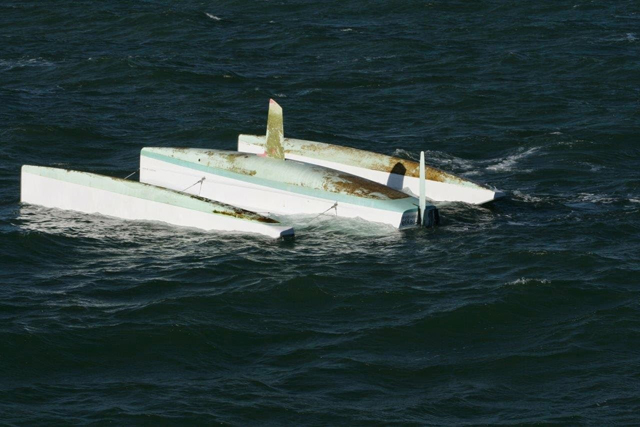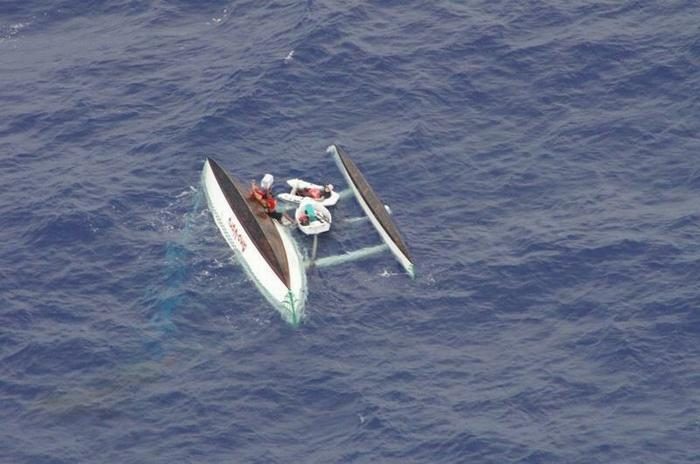We UN-Capsize A Proa!
Why is being able to un-capsize a proa such a big deal? Proas are unsinkable, right?
It’s important because we’re building an autonomous research proa (the ARC) that needs to be able to UN-capsize itself, thousands of miles out at sea during a research mission.
It’s true that well-built modern multihulls (catamarans, trimarans, and proas) ARE unsinkable.
But given big enough seas and enough wind, ANY cat, tri, or proa can capsize!
Capsize leaves you wet, cold, and exhausted, with your boat upside-down. When you capsize offshore, your boat doesn’t sink, but you’re in a life-or-death survival situation. Fire up the EPIRB (hope the battery is good), get on your survival suits, and pray.
IF you get rescued, you get to watch your boat disappear over the horizon as you leave on the rescue ship (and there’s no guarantee you WILL get rescued, that’s why you pray).
Catamarans capsize:
Trimarans capsize:
And proas capsize. At least, proas that have NO leeward bouyancy pods! See here for what proas with leeward bouyancy pods do (and it’s NOT capsize in this kind of sea conditions!).
Being able to un-capsize our ARC is essential to its operation (that’s our Autonomous Research Canoe, which is based on our prototype Pocket Rocket). What’s our ARC? It’s an inexpensive but capable robot sailboat designed to gather ocean data thousands of miles from land. Why does the ARC need to un-capsize itself?
Because even though it is very difficult to capsize, it can still do so in a big storm. And far from shore, no one can predict the weather, there are no “safe harbors” to shelter in, and there is no one to help un-capsize the boat. So a robot proa needs to be able to do that by itself. We started working on this problem in early 2020, and solved it in June of 2021.
Before we could un-capsize our proa, we needed to capsize it! We demonstrate here how difficult it is to capsize the 18-foot Pocket Rocket (the prototype for the ARC):
Next we demonstrate self-righting after a capsize on the Pocket Rocket:
It’s simple: we pumped water into the outrigger until it sank and was directly under the main hull; then we pumped air into the outrigger until it was bouyant again and it floated up on the other side. Now she was right-side-up, and all we had to do was finish pumping the rest of the water out of the outrigger and main hull.
There’s one more thing you need to know: we also put a weight inside the outrigger instead of just water; because no matter how much water we pumped inside, it never would have sunk the outrigger. That’s because you need more than just water to overcome the built-in bouyancy in the outrigger’s plywood and lumber. The weight was about 70 pounds: just big enough to overcome that bouyancy, and when we filled the outrigger with water, it sank nicely. You can use a bag of beach sand; it’s really cheap!
In the ARC, we replace the humans with sensors, batteries, and electric pumps. When the ARC flips over in a storm, the sensors detect it, actuate the pumps, and within about 20 minutes the ARC is back upright and sailing again, with all the water pumped back out of the outrigger (except for the normal water ballast she carries, which is in a separate tank). We don’t need a bag of sand in the ARC, because it has 100 pounds of batteries; we put them in a watertight compartment out in the ARC’s outrigger.
So now we’ve got an intelligent robot proa that can sail AND un-capsize itself a thousand miles from anywhere.
Why is that so important? Because it opens up a valuable data-gathering opportunity that isn’t possible with other autonomous boats: chasing hurricanes for weather data! We’ll talk about it on our ARC webpage here.
